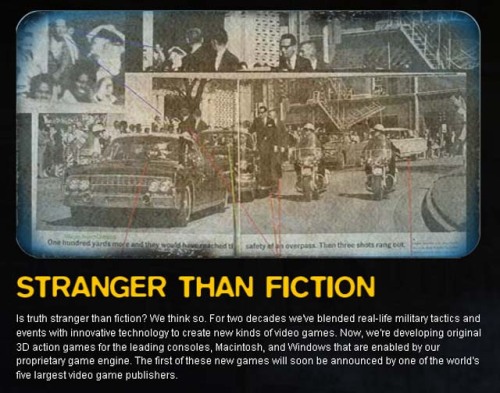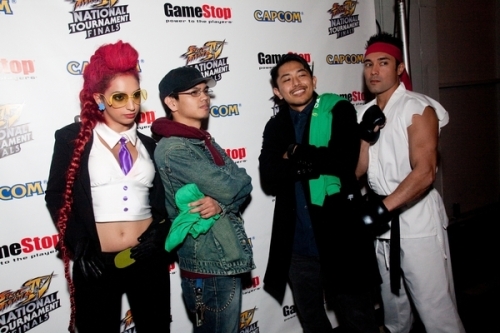Sometime shortly after September 11, 2001, the business of the video game industry changed. Unlike an earthquake that turns a crevice in the ground into a canyon, this American event shifted the plates underneath the ground, re-arranging pieces of the landscape.
Americans on the whole examined their daily lives and mourned the losses of those folks who died senselessly in New York. They examined the language they used. New military terms were introduced and became more familiar while, conversely, they were also examined more closely in everyday language. Many journalists thought twice about the terms “headshot,” “sniping,” and “blowing the shit out that guy.”
Well, OK, maybe some of thought about it…
Along with Los Angeles Times’ writer Alex Pham’s examination of PR junkets and a particular freelance writer’s “excessive” lifestyle, which explored the potential hazards of industry writers and their relationships with public relation teams, things got real quiet on the PR front. Road trips, big-time PR spectacles, and ATV events vanished. As the country settled into a new reality, the video game industry’s events slowly but surely returned, if only a little more reserved.

Junkets don't have to involve zebra-striped Hummer limos to be valuable and worthwhile. In fact, please, no more zebra-striped hummers. Please?
While no US citizen thought the September 11 attacks were a good thing (just ask the families whose relatives and friends died), the attack, in retrospect, made us examine our practices and values. And the trivial matter of a simple PR road trip designed to promote a game was among those things. Is an extravagant trip necessary? Is it in good taste? Does it exaggerate the violence in the game?
There is not a single junket where riding in a Hummer limousine made me feel anything but a false sense of self value. They were all fun and I appreciated the rides, but whatever games they were pimping weren’t affected in the slightest by that fleeting sense of the high life.
Several trips–including one of the best PR trips of my life, which was organized by former PR manager Mr. Matt Frary when he worked at Atari Games before they imploded–were simply incredible experiences in and of themselves. This particular Atari trip to Cabo San Lucas, Mexico, involved game journalists who saw two days worth of games (Driv3r, Transformers, etc.) while residing at a huge beach side resort in perfect weather. In between seeing games all day, during lunch and at night we lounged in a giant pool with a built-in bar that overlooked the beach. All drinks were charged to room 125 (Matt Frary’s room, of course!). Thank goodness, Atari decided to set an embargo date for three days afterward. The Internet connections were terrible and for those of us who stayed out late partying, we were in no shape to write a decent, legible sentence.
I will always appreciate that trip because the setting was beautiful and we were treated to a slice of paradise. I’m sorry, but drinking free unlimited margaritas in a pool by the beach in 85 degree weather is really fucking fun.
Could this trip have been organized in a simple hotel in Los Angeles without the frills? Yes. Would it have been as fun? No. And, perhaps equally worth questioning, would as many people have attended? Also, did Atari create a better image for itself and by association, one for Atari? Nah. Driv3r had the potential to be good, but it ended up being shit.
My thinking is that Atari got to spend quality time with journalists, and by spending that time, got them to think and spend time with their games. They also got dozens of stories and video pieces written about their products. The attending journalists got better insights into games that brought their sites traffic and readers. The revolution was complete.
In this case, the personal experience was greater than the professional experience, and the lasting value equaled a slew of coverage, and I think I got to like and value Matt Frary a whole lot more.

Driv3r didn't live up to the hype. (Image courtesy of IGN)
But I know just as many journalists who wouldn’t attend such an event because it was either a waste of time or it was against their journalistic ethics. More significantly, they would declare it as the “problem” with video game PR and game journalism. To that I simply say, bah! When Driv3r came out (I still hate that damned 3), I gave it a 5.5 out of 10 and Atari pulled its ads from IGN. If game journalists or game writers can’t separate the wheat from the chaff, and they’re swayed by a few drinks, a limo ride, or a free t-shirt, they’d better pick another profession. If a game sucks, it sucks. If it’s good, it’s good. And any PR person who dares to try and sway your review score should also jump ship, too.
I would venture to say there is great value in the PR junket, the PR outing, and the three-day trip to some crazy desert in Arizona (which I have been to twice for said events). But PR folks have to pick their place well and the event, and in my humble opinion, it has to provide intrinsic value and information about the game.
I remember IGN writer Steve Butts telling me with great appreciation (and exhaustion) that the Medal of Honor Pacific Assault boot camp event he attended was incredible. It gave him a direct insight into being a new soldier. He had the sunburn and blisters to prove it. This event took place in 2003 or 2004 and basically put journalists in real boot camp, running all day while wearing backpacks, shooting targets, and sleeping out in the open desert. The event created for journalists a sense of what it felt like to be a soldier and therefore provided an insight into the game, which in turn put value on presenting military authenticity.
Similarly, when I met Capt. Dale Dye in person at an EA event in Fort Mason promoting Medal of Honor 2 for PlayStation, I learned what I considered a great deal about military strategy. Dye, a retired U.S. army captain who has served as a consultant on military movies such as Saving Private Ryan, was hired as a consultant to Medal of Honor 2. Dye talked about the importance of attacking (having an entrance strategy), but also having a plan to complete the venture (having an exit strategy). He also revealed what it was like to fight in Vietnam in hand to hand combat, a grisly scenario of few bullets and one grenade and sheer smart timing–a scenario in which he lived to talk about it.
Had I not attended, I would have not met Dye. Also I would not have learned from his experiences, which I applied to all future World War II shooters and military based games.
Of course I have been to dozens of stupid, wasteful, and annoying trips. In many of those cases, I would have been more happy to simply receive a disc packed with information, screenshots, and videos. I can think of a half dozen Sony, Activision, Take Two, and Atari trips that were lavish and didn’t provide good people to interview or background data to inform my stories. The aforementioned Atari trip to Mexico was more fun than it was useful.
While this article might seem like a good excuse to reminisce about a great trip to Mexico, PR junkets can be a valuable tool for both the journalist and the PR manager. If video game events, junkets, and even spectacles are well thought out and are tied intrinsically to the game, they can inform and educate the press. Many don’t, but a good junket can provide a different perspective to a game that a poorly-paid, overworked game writer might not have considered. And, hopefully while said junkets are providing new insights, they’re a little fun, too.
ED NOTE: PR whiz Tom Ohle has just launched a new blog called EvolutionOfPR, in which this topic and many others revolving around the growth of public relations are discussed; it’s definitely worth a look.
 Damn it, EA. You with your new IPs, getting all literary.
Damn it, EA. You with your new IPs, getting all literary.




 Ubisoft just handed off a
Ubisoft just handed off a 




 Here’s a list of legal things that are also addicting: Coffee, caffeinated drinks, alcohol, television, cell phones, and sex. And, whatever it is that you really, really like, these are all things that have the mysterious spell that pulls humans away from everything else and makes them. I’m pretty sure most people I know are addicted to
Here’s a list of legal things that are also addicting: Coffee, caffeinated drinks, alcohol, television, cell phones, and sex. And, whatever it is that you really, really like, these are all things that have the mysterious spell that pulls humans away from everything else and makes them. I’m pretty sure most people I know are addicted to  Capcom and GameStop hosted the Street Fighter IV US National Championship Finals in San Francisco’s Fort Mason Saturday night, awarding Justin Wong, playing as the character Rufus, the national champion’s award. Wong took home a brand new Street Fighter IV arcade cabinet, a trophy, and the knowledge that he had serious nards to win as Rufus.
Capcom and GameStop hosted the Street Fighter IV US National Championship Finals in San Francisco’s Fort Mason Saturday night, awarding Justin Wong, playing as the character Rufus, the national champion’s award. Wong took home a brand new Street Fighter IV arcade cabinet, a trophy, and the knowledge that he had serious nards to win as Rufus.